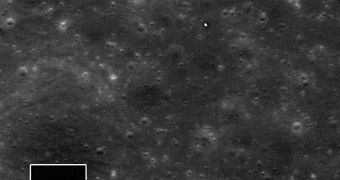Using data collected by a NASA spacecraft, experts were finally able to rediscover a long-lost, Soviet-built reflecting device on the surface of the Moon. The exact location of the scientific payload has remained a mystery since September 14, 1971. At that date, the Soviet Union lost contact with its Lunokhod 1 rover, which was carrying the mirrors. Nearly 40 years later, American physicists were able to identify the instrument using lasers beamed to the Moon all the way from Earth, Space reports.
The reflecting device itself was built by France for the Soviet Union, and it landed on the natural satellite on November 17, 1970, aboard the lander segment of the Lunokhod 1 mission. The rover was then deployed, and began its trek across the lunar surface. Eventually, in September the following year, contact with the small exploration robot was lost, and its location became a mystery. “No one had seen the reflector since 1971,” explains University of California in San Diego (UCSD) associate professor of physics Tom Murphy, who led the group that identified the Russian instrument.
This particular science team has been conducting laser experiments between Earth and the Moon for several decades. NASA has its own mirrors placed on the natural satellite, and laser beams shone on them help physicists test for gaps in Einstein's Theory of General Relativity. Light emitted from special facilities here travels to the mirrors, and then gets reflected back. The experts then look at the modifications the laser beam suffered, and calculate if the time needed for it to return is in tune with theoretical predictions based on Albert Einstein's calculations.
“We routinely use the three hardy reflectors placed on the moon by the Apollo 11, 14 and 15 missions, and occasionally the Soviet-landed Lunokhod 2 reflector – though it does not work well enough to use when illuminated by sunlight. But we yearned to find Lunokhod 1,” Murphy adds. Over the past two years, the group occasionally took some time from their work to look for the rover, but the breakthrough came only last month, when new images from the NASA Lunar Reconnaissance Orbiter (LRO) were made available.
Snapped using the Lunar Reconnaissance Orbiter Camera (LROC) instrument, the photographs were sufficiently detailed to allow for the team to identify the rover as a speck of dust in the desolate lunar landscape. The machine was located miles from where initial estimates had placed it, and from where Murphy and his team had been looking for it. Using the 3.5-meter telescope at the Apache Point Observatory, in New Mexico, the researchers sent a beam of laser light in the direction of the reflecting device, and even managed to get a hit back.
“We quickly verified the signal to be real and found it to be surprisingly bright: at least five times brighter than the other Soviet reflector, on the Lunokhod 2 rover, to which we routinely send laser pulses. The best signal we've seen from Lunokhod 2 in several years of effort is 750 return photons, but we got about 2,000 photons from Lunokhod 1 on our first try. It's got a lot to say after almost 40 years of silence,” Murphy reveals.
“Not only now do we know that Lunokhod 1 is there, we also know that it is parked perfectly so that its reflector faces Earth. In fact, the signal is so surprisingly strong that the rover could not be in anything but a level parking spot with its commanded roll on the lunar surface deliberately oriented toward the Earth,” the expert concludes.

 14 DAY TRIAL //
14 DAY TRIAL //